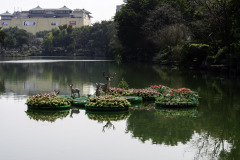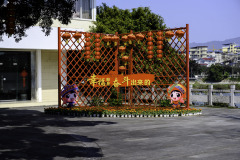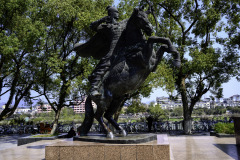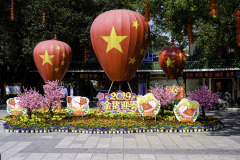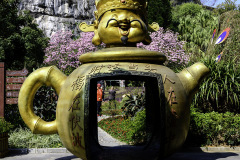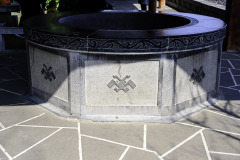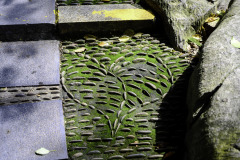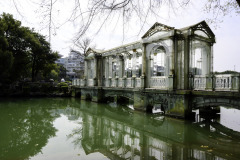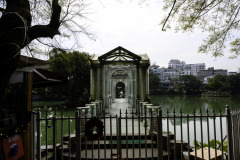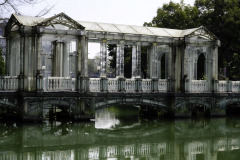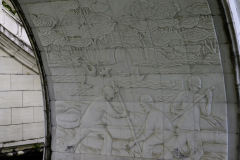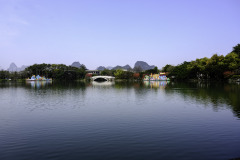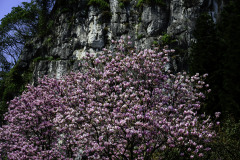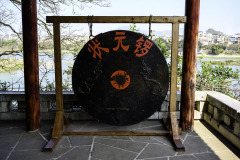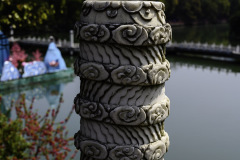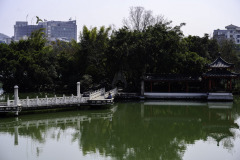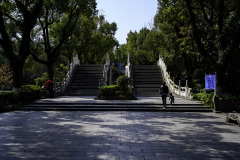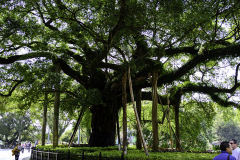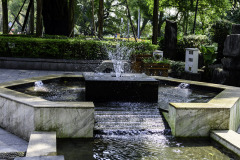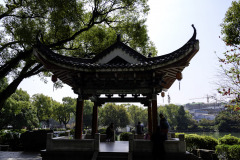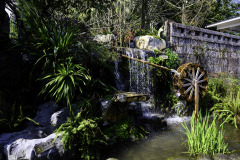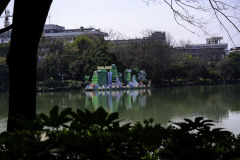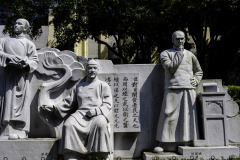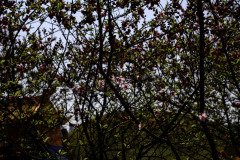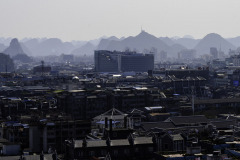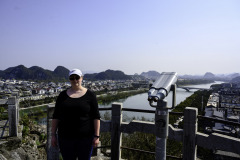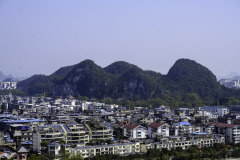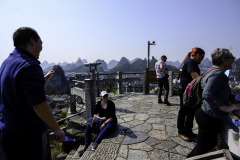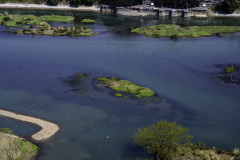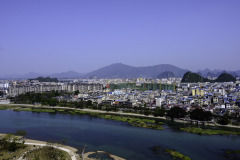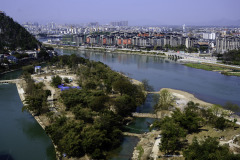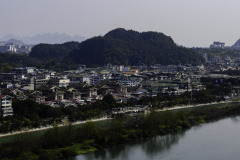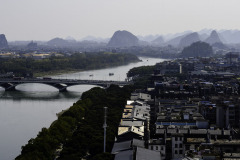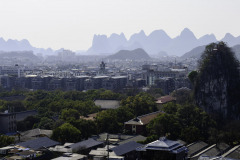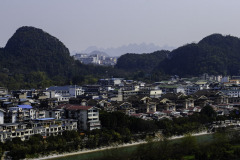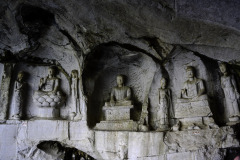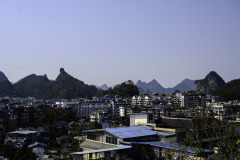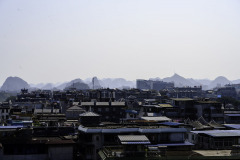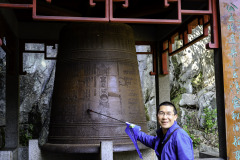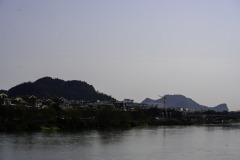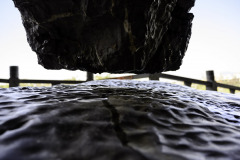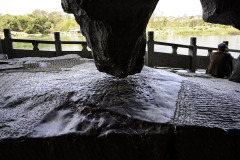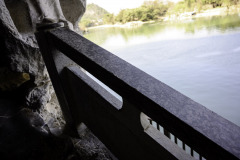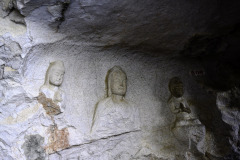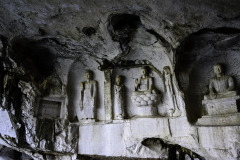As soon as we got outside of the airport we were met by a waft of fresh air! It was like the direct opposite of Xi’an; everything was so lush and green that you couldn’t not appreciate the cleanliness of the air.
Johnny was our specialist for Guilin and Yangshuo and a friend of Peter’s. Guilin is also Peter’s home town so there were a few jokes around staying at his home.
The first stop for Guilin was a park nearby the city wall, which included its famous crystal (or glass) bridge.
I didn’t realise until a few minutes later that I had been quite lucky to get a photo of the float that the deer was on; you couldn’t tell initially but the float was very slowly rotating in the water. A few minutes after taking the photo the deer was facing to the right.
For the heart of stones this was the only set of stones next to the steps around the area that had a shape so I had to take a snap. For the alleyway I just found it interesting on the way back to the coach.
Thousand Men Pot: This pot was in the second year of Emperor Kangxi period in Qing Dynasty (1663AD) in Foshan. It was originally used as the instrument for burning incense in the Dingyue Temple at the foot of Diecai Hill. During the War of Resistance Against Japan, Dingyue Temple was destroyed and the iron pot and the iron bell were transferred to the foot of Fubo Hill. The iron pot weighs 1000Kg (1 tonne) and measures 1.5m wide and 0.8m deep. It is said it can hold 3 loads of rice for one thousand men so it is called “thousand Men Pot”. Along the edge of the pot are some inscriptions. It is a precious object to study the casting and smelting craft in the early Qing Dynasty.
Sadly, I wasn’t able to take a photo of someone in the pot as it’s prohibited.
Judging by the decorations adorning the entrance I assumed that the crystal bridge hadn’t been opened for a while. It’s a shame it wasn’t a little cleaner too but it was still an interesting sight. Walking around the park really let you appreciate how much clean and fresh the city was!
Located in Rong Lake, Glass Bridge, 22.4m long and 2.64m wide is Chinese first practical bridge adopted special crystal glass architecture. The reason why it is known as Crystal Glass Bridge is that it utilises delicate and sophisticated crystal glass in external facade and rain gallery roof as well as the deck load-bearing parts. Building components like stigma, railings and other bridge components are also casted by elegant crystal glass products. Bridge Gallery is the European style with the beautiful shape and the crystal Structure. Standing on the bridge, you will produce the floating feeling. In the morning sun and the setting sun it is like a magnificent palace; against the fantastic light changes at night, it is like the Alice’s fairy tale world. In the rainy season in spring the Glass Bridge is looming in the fog and hazy mist, giving a sense of transcendence.
Next up was a trip to a pearl shop, where they processed fresh water pearls (oysters of which provide a single pearl and is more expensive) and seawater pearls (which are cheaper as the oysters provide multiple pearls). I didn’t actually take any photos as you don’t see the process as such – the rep just demonstrated opening an oyster that they had already prepared for demonstration. The prices of the pearls could just blow your mind – because the whole process from Oyster to jewellery was all done locally the prices were about a tenth of what you’d likely pay abroad.
At some point we were bound to come across a a height that rivalled the Great Wall and St. Paul’s Cathedral for a challenging set of stairs. I just didn’t expect that to be so soon and in the form of a hill – Fubo Hill, specifically. Needless to say it was worth it – the sights were breathtaking, both figuratively and literally. The bell, just to give a bit of context here, is at the foot of the hill and (apparently) used to be rung for many common uses – signalling lunch, dinner, end of day, etc.
You know it’s going to be a steep climb when there’s a warning message at the foot of the hill stating that visitors with heart, breathing or blood pressure issues should be cautious.
This pot was cast in the eighth year of Emperor Kangxi period in Qing Dynasty (1669AD) in Foshan. It was originally used as the instrument in the Dinyue Temple at the foot of Diecai Hill. During the War of Resistance Against Japan, Dingyue Temple was destroyed and the iron bell was transferred to the foot of Fubo Hill. The bells is 2,524Kg (around 2.5 tonnes) and measures 2.5m high and 1.7m wide.
After descending down to ground level we U-turned round the corner to another set of steps to descend even further. This led to carvings of Buddha in the ceilings. There was also a shrine mid-way through the cave, where you’re not allowed to take photos.
Fubo Hill now has more than 100 stone inscriptions, most of which are spread in Returned Pearl Cave with calligraphy, paintings and sculptures. In calligraphy it includes different typefaces such as cursive style, regular script, clerical script and grass script. The earliest inscriptions originated from Tang Dynasty, which has a history of more than 1,100 years. It lasted to the Republic of China, with the flourishing period in Song Dynasty. The content includes narration and lyrcs, in which the most popular ones are tourism inscriptions. Among them, the most valuable are the self-portrait and autograph of Mi Fu (1051-1107), famous calligrapher of Song Dynasty. Currently, Fubo Hill has 36 niches of bas-reliefs on precipices, which is 239 in total. Most of them are scattered in Thousand Buddha Rock, with Returned Pearl in second place. Most of the works were produced after Emperor Xuanzong worshippe Buddha Dharma. On the southeast wall of the rock are several statues with a large size. They are Candana Buddha, Three Idols of Avatamsata and Amitabha of Buddha Shakyamuni. On the west wall of the rock are two Taoism statues in Song Dynasty, which is very rare and precious among the numerous bas-reliefs on precipices in Guilin.
The dark rock with the gap is the Sword-Testing Stone. It is one of the famous scenic spots of Guilin. It is named after its peculiar shape, the 4-5cm wide gap between the drooping stone pillars and the smooth huge stone at the bottom, which seems as it was cut by a sword. Actually, Sword-Testing Stone is just an incomplete pillar formed by the eroding of limestone. Its bottom is a layer of extremely thin calcareous shale and with the long-term washing of water it erodes among the layers, forming this gap as if cut by sword. Until today, we can still find this thin layer of shale in the corresponding position in the south wall of the cave.
That evening we walked through a very popular main street of Guilin, where we had dinner upstairs. Surprisingly, this tasted like Westernised Chinese, where the food was more greasy and seemed like it was caked in MSG, whereas none of the previous meals had the “coated” sensation like westernised Chinese food does. We then had a walk through the town back to the hotel.
